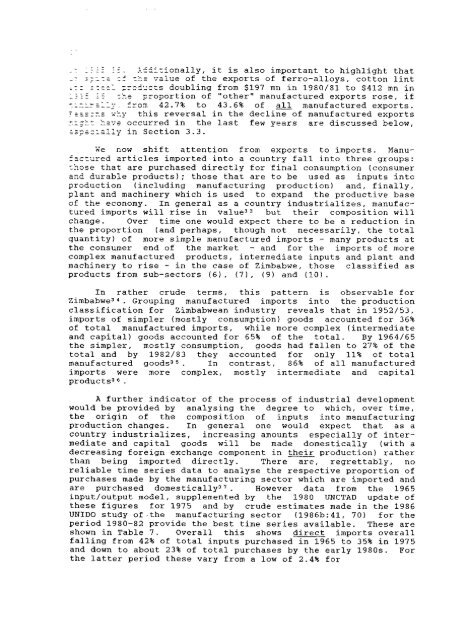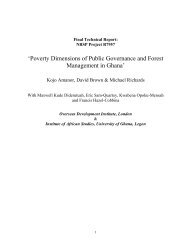Zimbabwe - Overseas Development Institute
Zimbabwe - Overseas Development Institute
Zimbabwe - Overseas Development Institute
Create successful ePaper yourself
Turn your PDF publications into a flip-book with our unique Google optimized e-Paper software.
i-iz Additionally, i t i s also important to h i g h l i g h t that<br />
..T zz ths value of the exports of f e r r o - a l l o y s , cotton l i n t<br />
= -.z I'.eel products doubling from $197 mn i n 1980/81 to $412 mn i n<br />
iilz li z'r.a proportion of "other" manufactured exports rose, i f<br />
-L--_r = llT, from 42.7% to 43.6% of a l l manufactured exports.<br />
? = = £:r-S *-:-y t h i s r e v e r s a l i n the d e c l i n e of manufactured exports<br />
r,-g"-t have occurred i n the l a s t few years are discussed below,<br />
e s p e c i a l l y i n Section 3.3.<br />
We now s h i f t a t t e n t i o n from exports to imports. Manufactured<br />
a r t i c l e s imported i n t o a country f a l l i n t o three groups:<br />
those that are purchased d i r e c t l y for f i n a l consumption (consumer<br />
and durable products); those that are to be used as inputs i n t o<br />
production ( i n c l u d i n g manufacturing production) and, f i n a l l y ,<br />
plant and machinery which i s used to expand the productive base<br />
of the economy. In general as a country i n d u s t r i a l i z e s , manufactured<br />
imports w i l l r i s e i n value^^ but t h e i r composition w i l l<br />
change. Over time one would expect there to be a reduction i n<br />
the proportion (and perhaps, though not n e c e s s a r i l y , the t o t a l<br />
quantity) of more simple manufactured imports - many products at<br />
the consumer end of the market - and f o r the imports of more<br />
complex manufactured products, intermediate inputs and plant and<br />
machinery to r i s e - i n the case of <strong>Zimbabwe</strong>, those c l a s s i f i e d as<br />
products from sub-sectors (6), (7), (9) and (10).<br />
In rather crude terms, t h i s pattern i s observable f o r<br />
<strong>Zimbabwe</strong>'". Grouping manufactured imports i n t o the production<br />
c l a s s i f i c a t i o n for <strong>Zimbabwe</strong>an industry reveals that i n 1952/53,<br />
imports of simpler (mostly consumption) goods accounted f o r 36%<br />
of t o t a l manufactured imports, while more complex (intermediate<br />
and c a p i t a l ) goods accounted f o r 65% of the t o t a l . By 1964/65<br />
the simpler, mostly consumption, goods had f a l l e n to 27% of the<br />
t o t a l and by 1982/83 they accounted f o r only 11% of t o t a l<br />
manufactured goods''. In contrast, 86% of a l l manufactured<br />
imports were more complex, mostly intermediate and c a p i t a l<br />
products' * .<br />
A f u r t h e r i n d i c a t o r of the process of i n d u s t r i a l development<br />
would be provided by analysing the degree to which, over time,<br />
the o r i g i n of the composition of inputs i n t o manufacturing<br />
production changes. In general one would expect that as a<br />
country i n d u s t r i a l i z e s , i n c r e a s i n g amounts e s p e c i a l l y of i n t e r <br />
mediate and c a p i t a l goods w i l l be made domestically (with a<br />
decreasing f o r e i g n exchange component i n t h e i r production) rather<br />
than being imported d i r e c t l y . There are, r e g r e t t a b l y , no<br />
r e l i a b l e time s e r i e s data to analyse the respective proportion of<br />
purchases made by the manufacturing sector which are imported and<br />
are purchased d o m e s t i c a l l y " . However data from the 1965<br />
input/output model, supplemented by the 1980 UNCTAD update of<br />
these f i g u r e s f o r 1975 and by crude estimates made i n the 1986<br />
UNIDO study of.the manufacturing sector (1986b:41, 70) f o r the<br />
period 1980-82 provide the best time s e r i e s a v a i l a b l e . These are<br />
shown i n Table 7. O v e r a l l t h i s shows d i r e c t imports o v e r a l l<br />
f a l l i n g from 42% of t o t a l inputs purchased i n 1965 to 35% i n 1975<br />
and down to about 23% of t o t a l purchases by the e a r l y 1980s. For<br />
the l a t t e r period these vary from a low of 2.4% for
















